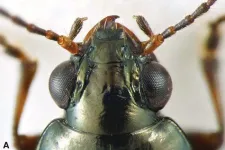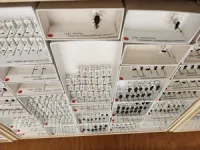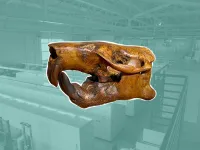(Press-News.org) Berkeley — When University of California, Berkeley, entomologist Kipling Will first heard that former Gov. Jerry Brown was hosting field scientists on his Colusa County ranch, he jumped at the chance to hunt for beetles on the property.
“I reached out and said, ‘Hey, I want to sample your beetles,’” Will said. “And [Brown] was quite game to let me come up there.”
Will, a professor of environmental science, policy and management, has travelled to all corners of California to study carabid beetles, ground beetles that are important predators of other insects in agricultural and garden settings. But Will’s repeated visits to Brown’s ranch proved especially fruitful.
While sampling for insects near Freshwater Creek, Will collected a rare species of beetle that had never been named or described — and which, according to records, had not been observed by scientists in over 55 years. The new species will be named Bembidion brownorum, in honor of Brown and his wife, Anne Brown.
“I'm very glad that [my ranch] is advancing science in some interesting and important ways,” said Brown, who has hosted a wild variety of field researchers, including geologists, anthropologists and botanists, on the property. “There are so many undiscovered species. I think it's very important that we catalog and discover what we have and understand their impact on the environment — how it's functioning and how it’s changing.”
Brown’s 2,500-acre ranch is about an hour’s drive north of Sacramento, in an agricultural region where most of the land is privately owned and insect biodiversity is historically understudied. For more than two years, Will has regularly sampled for insects on the ranch, sometimes even showing the beetles that he finds to the Browns.
Jerry Brown said his dedication to welcoming researchers onto his land is rooted in the ranch’s history as a stagecoach stop called Mountain House, and in his own interest in climate change and conservation.
“We don't have stagecoach stop, but we have a place of gathering, of research and collaboration,” said Brown, who is currently chair of the California-China Climate Institute at UC Berkeley.
After collecting a beetle at the ranch that didn’t resemble any species he was familiar with, Will called up Bembidion expert David Maddison, a professor of integrative biology at Oregon State University, to help identify the specimen. Together, the scientists used morphological and DNA analysis to confirm that the beetle represented a completely new species.
Will then combed through entomology collections at museums throughout California in search of other specimens that may have been unlabeled or misidentified. He found only 21 other specimens of the species, the most recent of which was collected in 1966.
The lack of any more recent specimens indicated to him that the species likely collapsed during the second half of the 20th century, driven out of its natural habitat by rapid urbanization and agricultural development across the state.
“The sad truth is, [the species] has probably been in a huge decline. If you look at the places that it was found the ‘20s and ‘30s and ‘40s, almost none of that natural habitat is left,” Will said. “But we don't know for sure. So, the thing to do is to get it out there, describe it and tell people, ‘Hey, look for this thing,’ because maybe we'll find some place where it's doing fine.
“Having access to Jerry’s ranch in Colusa County gives me the opportunity to really spend time sampling, to look for rare things like this.”
Will and Maddison describe Bembidion brownorum in a study published today in the journal Zookeys.
Big for a Bembidion
To the naked eye, Bembidion brownorum isn’t particularly remarkable: The diminutive beetle is brown in color and measures around 5 millimeters in length, about the diameter of a standard pencil. But under magnification, it glows with a green and gold metallic shimmer.
It was the unusual shape of the beetle’s prothorax, the segment of the insect that sits right behind its head, that first caught Will’s eye.
“I was looking at this one beetle thinking, ‘It just doesn't fit any of the ones that I can identify,’” Will said. “The shape of prothorax is just not like any of the others.”
According to Maddison, Bembidion brownorum is also relatively large compared to other Bembidion beetles, which are usually closer to 3 to 4 millimeters in length.
“It’s big for a Bembidion,” Maddison said. “At first glance, it was pretty obvious that it was probably something new.”
With so few examples to study, it’s difficult to describe the lifestyle and behavior of Bembidion brownorum with any certainty, Will said. However, given where the beetle was found on Brown’s ranch — in the vicinity of Freshwater Creek, which occasionally dries into a series of trellis-like pools in the summer months — it is likely that the beetle lives near the edges of bodies of water that periodically flood and then evaporate.
The 21 historical specimens of Bembidion brownorum are housed at either the Essig Museum Entomology Collection at UC Berkeley or at the California Academy of Sciences in San Francisco, which both have insect specimens going back more than 100 years. The discovery highlights the vital importance of maintaining these collections for current and future research, the scientists said.
“One of the things that I find interesting about is that, before Kip found that specimen, there were already specimens in collections — there was this hidden diversity that people didn't recognize,” Maddison said. “At one point, [the beetle] probably was much more widespread and much more common, and Kip and I have some ideas as to where you would target to try to find more.”
Previous specimens were collected at locations throughout the Central Valley and in the Los Angeles Basin, regions that have been transformed over the last century. While the beetle may still survive in some areas, Will said that the patchwork of private landownership may make it difficult to find.
“There is a lot of desire to conserve the environment and combat climate change, but in many cases, we're not keeping up with the rate of extinction — we're not able to describe the species that need to be described as fast as things are going extinct,” Will said. “And this certainly is true in California, where there are an awful lot of undescribed insects out there and not a lot being done to get them described. I think that having more knowledge of what they are and where they where they live is really fundamental.”
John S. Sproul of the University of Nebraska Omaha is also a co-author of the study. This research was supported by the Harold E. and Leona M. Rice Endowment Fund at Oregon State University.
END
Rare beetle, rediscovered after 55 years, named in honor of Jerry Brown
While sampling for insects on the former governor’s ranch, a UC Berkeley researcher found a species of beetle that has not been observed by scientists since 1966
2023-03-27
ELSE PRESS RELEASES FROM THIS DATE:
JNM explores potential applications for ChatGPT in nuclear medicine and molecular imaging
2023-03-27
Reston, VA—A new article in The Journal of Nuclear Medicine explores the potential for using ChatGPT, an artificial intelligence chatbot, in the field of nuclear medicine and molecular imaging. In the article, Irène Buvat, PhD, and Wolfgang Weber, MD, PhD, report on discussions they held with ChatGPT regarding several nuclear medicine and molecular imaging topics and provide their commentary on the pros and cons of using the chatbot.
Developed by OpenAI, ChatGPT is a natural language processing chatbot that can intelligently respond to questions. ...
Aging | Parsing chronological and biological age effects on vaccine responses
2023-03-27
“Ultimately, while both chronological and biological age appear to be important determinants of vaccine-preventable outcomes in older adults, the underlying context and mechanisms of their effects remain unclear.”
BUFFALO, NY- March 27, 2023 – A new editorial paper was published in Aging (listed by MEDLINE/PubMed as "Aging (Albany NY)" and "Aging-US" by Web of Science) Volume 15, Issue 5, entitled, “Parsing chronological and biological age effects on vaccine responses.”
Researchers ...
Beneficial bacteria in the infant gut uses nitrogen from breast milk to support baby’s health
2023-03-27
A University of Massachusetts Amherst nutrition scientist who has spent his career studying breast milk has demonstrated how beneficial microbes in the gut of infants use nitrogen from human milk to support pediatric nutrition and development.
“The molecules in breast milk not only feed the baby but also feed the baby’s microbiome,” says David Sela, associate professor of food science and director of the Fergus M. Clydesdale Center for Foods for Health and Wellness. “This ...
Study finds neighborhood apps increase perceptions of crime rates
2023-03-27
How often do you glance at your neighborhood app, like Nextdoor or others, and learn about some crime in your area? Surely, it was not the intention of the app developers, but every time you hear of a crime nearby you might think that crime in your area is rampant. A new study by a University of Houston psychologist indicates that is exactly how the mind works – those helpful and popular neighborhood apps are actually increasing perceptions of crime rates that may not be as high as you think.
“Neighborhood ...
Can cannabis use disorder be accurately diagnosed?
2023-03-27
Cannabis use disorder is defined by the Diagnostic and Statistical Manual of Mental Disorders as a problematic pattern leading to clinically significant impairment or distress, with symptoms that may include increased tolerance, withdrawal symptoms, strong desire to use marijuana and spending large amounts of time using cannabis.
Tammy Chung, director of the Center for Population Behavioral Health at Rutgers Institute for Health, Health Care Policy and Aging Research, along with colleagues Marc Steinberg of Rutgers Robert Wood Johnson Medical School and Mary Barna Bridgeman of the Rutgers ...
SCAI and HRS release expert consensus on transcatheter left atrial appendage closure
2023-03-27
WASHINGTON (March 27, 2023) – Today, the Society for Cardiovascular Angiography & Interventions (SCAI) and the Heart Rhythm Society (HRS) released an updated expert consensus statement on transcatheter left atrial appendage closure (LAAC). SCAI and HRS prioritized the development of an updated consensus statement to provide recommendations on contemporary, evidence-based best practices for transcatheter LAAC focusing on endovascular devices.
Left atrial appendage closure is a minimally invasive procedure that is used to reduce the risk of stroke associated with atrial fibrillation. ...
Beaver fossil named after Buc-ee’s
2023-03-27
A new species of ancient beaver that was rediscovered by researchers in The University of Texas at Austin’s fossil collections has been named after Buc-ee’s, a Texas-based chain of popular travel centers known for its cartoon beaver mascot.
The beaver is called Anchitheriomys buceei, or “A. buceei” for short.
Steve May, a research associate at the UT Jackson School of Geosciences, said that the beaver’s Texas connection and a chance encounter with a Buc-ee’s billboard are what inspired the name.
May is the lead author of the paper that describes A. buceei, along with another, much smaller, species of fossil beaver. Published ...
James Chappell wins NSF CAREER Award
2023-03-27
HOUSTON – (March 27, 2023) – Rice University bioscientist and synthetic biologist James Chappell has won a National Science Foundation CAREER Award to develop RNA programming methods to improve human health and the environment.
“Synthetic biology has progressed a lot in the past decade, and we’ve gotten really good at genetically programming microbes in confined laboratory environments where conditions are ideal,” said Chappell, an assistant professor both of biosciences and of bioengineering. “But, of course, most microbes on the planet don't live in pure cultures where the temperature is always 37 degrees ...
In bid to make child cancer treatments safer, scientists find possible warning signs of severe reaction
2023-03-27
Scientists seeking a way to eliminate an adverse reaction to treatments for acute lymphocytic leukemia, a common childhood cancer, have found what they believe to be an early warning indicator.
Mouse studies conducted by Rutgers researchers as part of a larger scientific team are pointing to vitamin A levels as a signal that a patient may or may not be vulnerable to a dangerous toxicity.
Summarizing their findings in Science Translational Medicine, the scientists found that, in patients being treated for acute lymphocytic leukemia with the chemotherapy drug asparaginase, there is an ...
HIV can persist for years in myeloid cells of people on antiretroviral therapy
2023-03-27
A subset of white blood cells, known as myeloid cells, can harbor HIV in people who have been virally suppressed for years on antiretroviral therapy, according to findings from a small study supported by the National Institutes of Health. In the study, researchers used a new quantitative method to show that HIV in specific myeloid cells—short-lived monocytes and longer-lived monocyte-derived macrophages—can be reactivated and infect new cells. The findings, published in Nature Microbiology, suggest that ...
LAST 30 PRESS RELEASES:
Researchers identify gene that calms the mind and improves attention in mice
Artificial metabolism turns waste CO2 into useful chemicals
Ancient sea anemone sheds light on animal cell type evolution
Begging gene leads to drone food
How climate policies that incentivize and penalize can drive the clean energy transition
Can community awareness campaigns in low-resource areas improve early diagnosis of colorectal cancer?
Stardust study resets how life’s atoms spread through space
Practical education: Clinical scenario-based program development
The impact of family dynamics on eating behaviour – how going home for Christmas can change how you eat
Tracing the quick synthesis of an industrially important catalyst
New software sheds light on cancer’s hidden genetic networks
UT Health San Antonio awarded $3 million in CPRIT grants to bolster cancer research and prevention efforts in South Texas
Third symposium spotlights global challenge of new contaminants in China’s fight against pollution
From straw to soil harmony: International team reveals how biochar supercharges carbon-smart farming
Myeloma: How AI is redrawing the map of cancer care
Manhattan E. Charurat, Ph.D., MHS invested as the Homer and Martha Gudelsky Distinguished Professor in Medicine at the University of Maryland School of Medicine
Insilico Medicine’s Pharma.AI Q4 Winter Launch Recap: Revolutionizing drug discovery with cutting-edge AI innovations, accelerating the path to pharmaceutical superintelligence
Nanoplastics have diet-dependent impacts on digestive system health
Brain neuron death occurs throughout life and increases with age, a natural human protein drug may halt neuron death in Alzheimer’s disease
SPIE and CLP announce the recipients of the 2025 Advanced Photonics Young Innovator Award
Lessons from the Caldor Fire’s Christmas Valley ‘Miracle’
Ant societies rose by trading individual protection for collective power
Research reveals how ancient viral DNA shapes early embryonic development
A molecular gatekeeper that controls protein synthesis
New ‘cloaking device’ concept to shield sensitive tech from magnetic fields
Researchers show impact of mountain building and climate change on alpine biodiversity
Study models the transition from Neanderthals to modern humans in Europe
University of Phoenix College of Doctoral Studies releases white paper on AI-driven skilling to reduce burnout and restore worker autonomy
AIs fail at the game of visual “telephone”
The levers for a sustainable food system
[Press-News.org] Rare beetle, rediscovered after 55 years, named in honor of Jerry BrownWhile sampling for insects on the former governor’s ranch, a UC Berkeley researcher found a species of beetle that has not been observed by scientists since 1966








